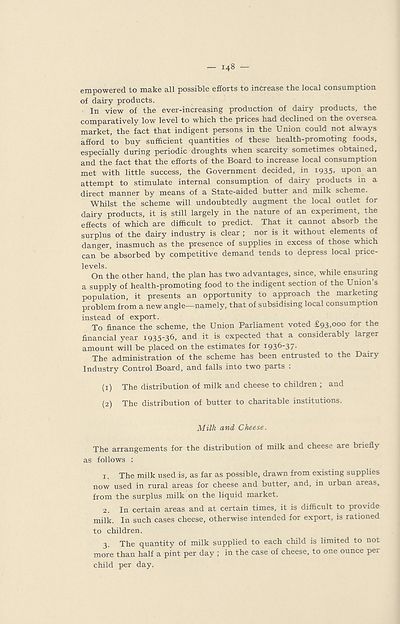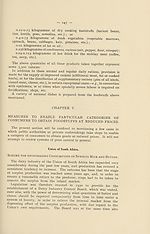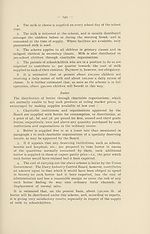Download files
Complete book:
Individual page:
Thumbnail gallery: Grid view | List view

— 148 —
empowered to make all possible efforts to increase the local consumption
of dairy products.
In view of the ever-increasing production of dairy products, the
comparatively low level to which the prices had declined on the oversea
market, the fact that indigent persons in the Union could not always
afford to buy sufficient quantities of these health-promoting foods,
especially during periodic droughts when scarcity sometimes obtained,
and the fact that the efforts of the Board to increase local consumption
met with little success, the Government decided, in 1935, upon an
attempt to stimulate internal consumption of dairy products in a
direct manner by means of a State-aided butter and milk scheme.
Whilst the scheme will undoubtedly augment the local outlet for
dairy products, it is still largely in the nature of an experiment, the
effects of which are difficult to predict. That it cannot absorb the
surplus of the dairy industry is clear ; nor is it without elements of
danger, inasmuch as the presence of supplies in excess of those which
can be absorbed by competitive demand tends to depress local price-
levels.
On the other hand, the plan has two advantages, since, while ensuring
a supply of health-promoting food to the indigent section of the Union’s
population, it presents an opportunity to approach the marketing
problem from a new angle—namely, that of subsidising local consumption
instead of export.
To finance the scheme, the Union Parliament voted £93,00° for the
financial year 1935-36, and it is expected that a considerably larger
amount will be placed on the estimates for 1936-37-
The administration of the scheme has been entrusted to the Dairy
Industry Control Board, and falls into two parts .
(1) The distribution of milk and cheese to children ; and
(2) The distribution of butter to charitable institutions.
Milk and Cheese.
The arrangements for the distribution of milk and cheese are briefly
as follows :
1 The milk used is, as far as possible, drawn from existing supplies
now used in rural areas for cheese and butter, and, in urban areas,
from the surplus milk on the liquid market.
2. In certain areas and at certain times, it is difficult to provide
milk. In such cases cheese, otherwise intended for export, is rationed
to children.
3. The quantity of milk supplied to each child is limited to not
more than half a pint per day ; in the case of cheese, to one ounce per
child per day.
empowered to make all possible efforts to increase the local consumption
of dairy products.
In view of the ever-increasing production of dairy products, the
comparatively low level to which the prices had declined on the oversea
market, the fact that indigent persons in the Union could not always
afford to buy sufficient quantities of these health-promoting foods,
especially during periodic droughts when scarcity sometimes obtained,
and the fact that the efforts of the Board to increase local consumption
met with little success, the Government decided, in 1935, upon an
attempt to stimulate internal consumption of dairy products in a
direct manner by means of a State-aided butter and milk scheme.
Whilst the scheme will undoubtedly augment the local outlet for
dairy products, it is still largely in the nature of an experiment, the
effects of which are difficult to predict. That it cannot absorb the
surplus of the dairy industry is clear ; nor is it without elements of
danger, inasmuch as the presence of supplies in excess of those which
can be absorbed by competitive demand tends to depress local price-
levels.
On the other hand, the plan has two advantages, since, while ensuring
a supply of health-promoting food to the indigent section of the Union’s
population, it presents an opportunity to approach the marketing
problem from a new angle—namely, that of subsidising local consumption
instead of export.
To finance the scheme, the Union Parliament voted £93,00° for the
financial year 1935-36, and it is expected that a considerably larger
amount will be placed on the estimates for 1936-37-
The administration of the scheme has been entrusted to the Dairy
Industry Control Board, and falls into two parts .
(1) The distribution of milk and cheese to children ; and
(2) The distribution of butter to charitable institutions.
Milk and Cheese.
The arrangements for the distribution of milk and cheese are briefly
as follows :
1 The milk used is, as far as possible, drawn from existing supplies
now used in rural areas for cheese and butter, and, in urban areas,
from the surplus milk on the liquid market.
2. In certain areas and at certain times, it is difficult to provide
milk. In such cases cheese, otherwise intended for export, is rationed
to children.
3. The quantity of milk supplied to each child is limited to not
more than half a pint per day ; in the case of cheese, to one ounce per
child per day.
Set display mode to:
![]() Universal Viewer |
Universal Viewer | ![]() Mirador |
Large image | Transcription
Mirador |
Large image | Transcription
Images and transcriptions on this page, including medium image downloads, may be used under the Creative Commons Attribution 4.0 International Licence unless otherwise stated. ![]()
| League of Nations > Economic and financial section > Problem of nutrition > (150) |
|---|
| Permanent URL | https://digital.nls.uk/190925712 |
|---|
| Shelfmark | LN.II |
|---|
| Description | Over 1,200 documents from the non-political organs of the League of Nations that dealt with health, disarmament, economic and financial matters for the duration of the League (1919-1945). Also online are statistical bulletins, essential facts, and an overview of the League by the first Secretary General, Sir Eric Drummond. These items are part of the Official Publications collection at the National Library of Scotland. |
|---|---|
| Additional NLS resources: |
|

